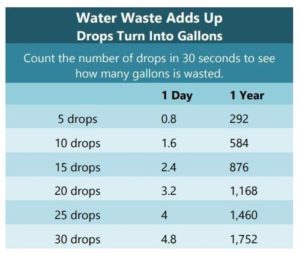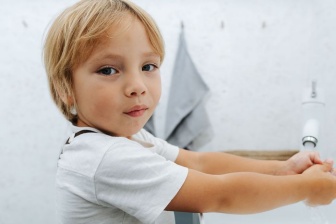8 ways to save lives and money for World Water Day — we each waste up to 30 gallons a day
News Category: News, Community News, and General Discussion
-
There’s some simple math that can tell you how much water you’re wasting when the bathroom faucet won’t quite shut off. The numbers may surprise you: 20 drips in 30 seconds adds up to more than three gallons a day and tops 1,100 gallons in a year.
Counting drips, tightening faucet connections, and turning off the running tap while shaving or brushing your teeth are small ways to save water PHO, +0.34% on an Earth covered with the stuff yet out of reach for some 2 billion people living globally without access to safe water for drinking and washing, according to the United Nations.
World Water Day, one of the U.N.’s campaigns for drawing attention to this vital resource, has been held on March 22 every year since 1993. It promotes education and policy as part of broader efforts to value and preserve Earth’s natural capital, support biodiversity, and counter climate change.
These are key issues across industries, from Coca-Cola KO, +0.90% pledging to replace in high-risk water areas as much water as it uses to make drinks, to the proliferation of low-flow showerheads and water-saving dishwasher cycles, to actor Matt Damon’s co-founding of water.org.

No matter where you live and your own access to potable water and water for showers, flushing, and lawns, think of “water efficiency” as a way to eliminate wasteful practices to help others, and save money.
The average American unknowingly wastes up to 30 gallons of water every day, according to the Washington State health department’s office of drinking water.
The Washington agency, plumbers groups, and the Environmental Protection Agency offer a few universal tricks for reducing water waste.
Buy a high-efficiency or low-flow toilet
The most important seat in the house is no doubt a major water user.According to the EPA, installing water-conserving toilets can reduce toilet water use by 20% to 60%, which means nearly 13,000 gallons saved per year. If every old and inefficient toilet in the U.S. was updated, the savings would be around 520 billion gallons of water per year. That’s the same amount of water that flows over Niagara Falls in about 12 days.
Upgrading to a water-saving toilet could save a household on average up to $110 a year on their water bill, and $2,200 over the lifetime of that toilet.
Is there a difference between a high-efficiency and a low-flow toilet? Yes.
Low-flow, or low-flush, toilets use one of two methods to clear waste: gravity or pressure assistance. Many cities and counties have begun passing conservation laws requiring homeowners and landlords to install low-flow toilets.
Energy-efficient toilets (also known as high-efficiency toilets or water-efficient toilets) may be more expensive at the outset but also are money-savers in the long run. They’re designed to remove waste by using water velocity instead of using water volume. So, these toilets also use less water but are designed to clear the waste effectively every flush, meaning you’re less likely to have to flush again. High-efficiency toilets use 1.28 gallons per flush or less. Plus, they now have flush ratings that can tell you just how well they perform.
Use this low-flow hack on any toilet
Not that long ago, wise homeowners told real estate newbies to put a brick in their toilet tank. The displacement ultimately reduced the amount of water that would refill the tank, which is much more than is typically needed for a single flush. Trouble was those bricks break down eventually.Another way is to recycle a two-liter soda bottle. Weight it down with pebbles or marbles so it doesn’t float and position it away from the flushing mechanics. Your two-liter displacement means a family of four flushers can save at least 3,000 gallons of water a year.
Leak repair
Replacement parts are inexpensive, often explained by YouTube videos, and can save you more than 10% on your water bill. In most cases, fixing a leaky toilet should cost you about $10 or less in parts. To check your toilet for leaks, drop food coloring in the toilet tank. If color appears in the bowl without flushing, you have a leak.You can fix most dripping faucets or showerheads by replacing worn washers.
Get in the habit: water off when brushing and shaving
Those two to three minutes without the sink running when brushing your teeth or shaving can save two to three gallons of water each day, according to the Glen Canyon Institute, a water conservation group.Take a shorter shower
Cut your shower time by 2-3 minutes and save up to 10 gallons of water per shower. Better yet, install EPA-approved WaterSense-labeled low-flow showerheads and save up to three gallons per minute. In fact, look on the package for just how many gallons a showerhead will use per minute, as they vary.Garden smarter
Collect rainwater to irrigate outdoor and indoor plants. Replace a lawn you have to mow with native or drought-resistant natural plants and grasses, known as xeriscape landscaping.If you have to water, do so in the early morning or evening. Watering during the
hottest part of the day, or when it’s windy, wastes water and is much less effective. You can also place a 2” to 4” layer of mulch around plants and trees to avoid excess evaporation and retain moisture. And protect water quality by limiting or eliminating the use of nitrogen-heavy commercial fertilizers, weed killers, and pesticides.Upgrade your washing machine
Look for ENERGY STAR-rated machines with low water use per load. ENERGY STAR is the EPA-approved program. Find a machine with a water factor of 4.5 or lower.Find a car wash that recycles water
Or skip the commercial car wash and control your own water use with a home car wash, maybe even on your lawn, so that runoff does double duty.


Leave a Reply